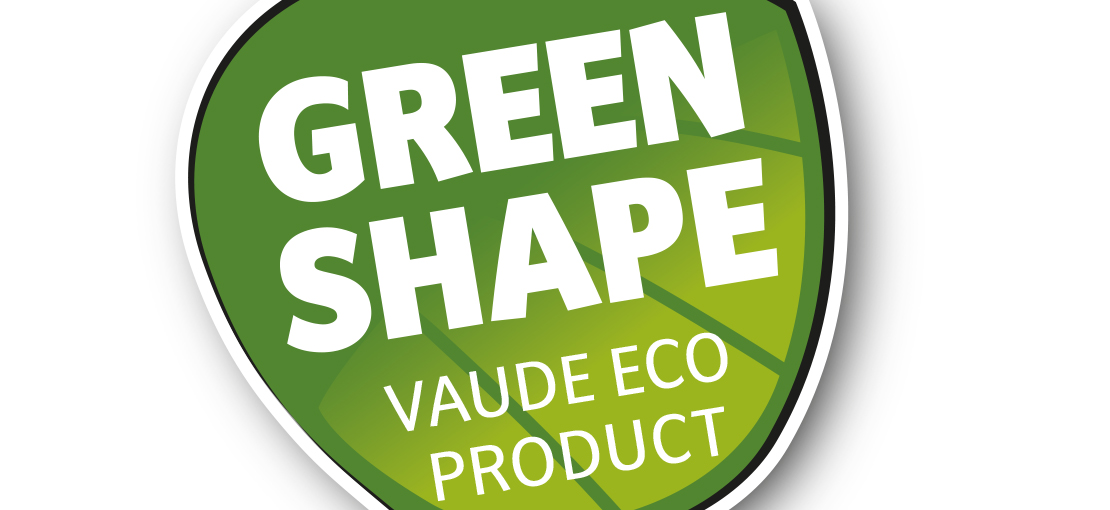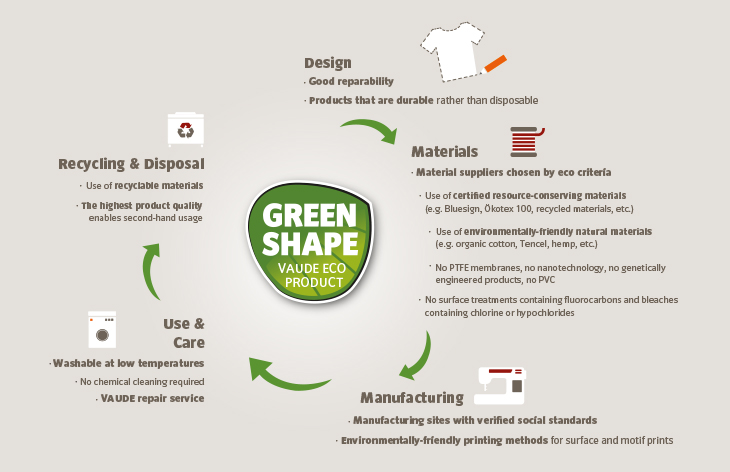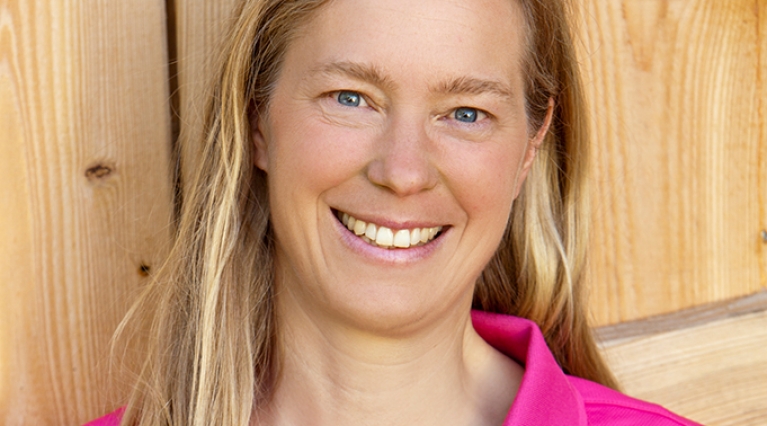
VAUDE Green Shape
VAUDE Eco Collection
Our Green Shape label offers functional, environmentally friendly products made from sustainable materials. We are vigilant about fair working conditions throughout the supply chain.
Our criteria for evaluation are stringent and transparent. They are reviewed regularly and cover the entire lifecycle of the product from design and production to maintenance, repair and disposal.
Pioneering work on criteria and transparency
How do you assess whether a material, process or product is environmentally friendly? Especially when there is no worldwide standard or comprehensive assessment system, and no certification, let alone something that would be acceptable internationally for all product groups? How do you decide whether a material, process or product is environmentally friendly? Especially when there are no worldwide standards, no operating evaluation systems, and no international or uniform certificates to go by.
Green Shape: strict criteria for environmentally friendly products
VAUDE is a pioneer in this field and has developed its own rating system for environmentally friendly outdoor products: Green Shape.
We use the VAUDE Green Shape criteria to evaluate our products with regard to their environmental friendliness.
Watch this short film explaining what Green Shape is about.
Sustainability throughout the entire product life cycle
Green Shape covers the entire product lifecycle with its strict standards – from design and production to maintenance, repair and disposal.
This means that not only the primary materials but also all production sites have to meet the high ecological standards for VAUDE Green Shape products.
In addition, all other components such as buttons, zips and prints must meet the stringent Green Shape criteria.

Aren't there enough eco labels as it is?
Who can understand all these labels anyway…? You might be right. So why does VAUDE have its own label?
In 2009, when we began to steadily steer our product development toward sustainability, awareness for the ecological and social aspects of clothing was only just beginning to develop.
The message was, that we should not only produce "better" (more environmentally friendly) products – customers should also be able to identify them as such in stores.
We searched high and low, but couldn’t find a quality seal that applied to our different product groups and our products (which are primarily made from synthetic fibers), and that could be used internationally.
This is why we developed the VAUDE Green Shape concept. VAUDE products that meet the Green Shape criteria are awarded the Green Shape Label. Green Shape has been around since 2010, and it has become very well established in the market. Now, it’s not just recognized by customers our like ourselves; more and more retailers are buying Green Shape products to make their product range more eco-friendly.
That is why we remain convinced that the VAUDE Green Shape label makes sense.
Green Shape 2.0 - all criteria
Green Shape has already gone through several stages of development. At the very beginning, Green Shape criteria included only the materials used. That was an important first step, but soon it was no longer enough for us. The Green Shape criteria now apply to the entire product lifecycle, from design, through all the materials used, production sites, use and care of the product, to possible recycling and/or environmentally friendly disposal.
Green Shape is a two-tier process: Each Green Shape product must be made from certified and/or environmentally friendly materials. At the same time, the production facility where the materials come from must also be environmentally certified. This doubles our safety net, especially with regard to handling chemicals in production.
Green Shape expressly excludes the use of particularly critical materials and technologies such as PVC, fluorocarbons, chlorine and bleaches containing hypochlorite, nanotechnology or solvent-containing prints.
Each Green Shape product must be easy to maintain and clean, and cannot require dry cleaning.
The bluesign® system is an important part of the concept. But Green Shape goes beyond the bluesign® system. Green Shape products may not, for example, contain fluorocarbons, while the bluesign® system still allows their use under strict conditions.
You can read the complete Green Shape Concept in detail here. A word of warning – it’s complex!
We are deliberately very transparent on this issue and publish the entire concept, the development of which we have put a lot of know-how into over the years. We have one request for this: If you want to use the Green Shape concept or parts of it, no matter if private or commercial, please always mention VAUDE Sport as author of the concept and this website as source.
If you have any questions, please don't hesitate to contact us.
Minimum material efficiency, repair index, recycling: Green Shape developments
- Mininum material efficiency:
We will establish a minimum level of material efficiency for Green Shape products to provide incentives for zero-waste design. To accomplish this, we have dealt with the issue of material efficiency very intensively in recent years:
We have worked together with our producers to create transparency about patterns and how individual pattern pieces are laid out on the fabric. This led to a material efficiency index and, at the same time, we were able to examine potential for optimization both in the design of the cuts and in the utilization of the fabric width. We are implementing this throughout our different product areas and gradually establishing binding minimum material efficiency values for all product areas. - VAUDE Repair Index:
Reparability plays an important role in the sustainability of each product. VAUDE already offers a whole bundle of services for our customers with our own Repair Service, a cooperation with iFixit and Repair Cafés so that their product can actually be repaired - read more here.
Now we are taking another big step: We have developed a repair index that we can use to continually examine and evaluate the repairability of all VAUDE products right from the start of the design phase and throughout the entire product development phase.
A point system is used to check which options for adjustment are available in the areas of design, material selection and processing technologies in order to increase reparability. Also taken into consideration: whether the repair can be carried out by the general public, with the help of repair cafés for example, or only by specialist companies such as the VAUDE Repair Service as well as whether spare parts are available and how much work is required for the repair.
Our goal is to achieve the best possible repairability without compromising functionality, durability, innovation, appearance and profitability. As with all sustainability issues, the challenge lies in achieving the best possible balance between all of these aspects.
All newly developed products of the Summer Collection 2020 have already been made using the new repair index.

»The repair index gives our customers the assurance that reparability in VAUDE products is not a coincidence, but one of the most important aspects in the product development stage.«
- Criteria for end-of-product-life recycling
Even the most functional, durable and repairable product arrives at the end of its product life cycle at some point. To ensure that it can then be truly recycled, we have established criteria for the selection of materials and processing technologies that go into effect right at beginning of the product development stage.
This means that the course is already set in the design phase to ensure that our products function in the recycling economy that we’re striving for – including the use of as many recycled materials as possible, the return of products after their useful life, and the technical recycling of individual materials.
Together with a group of students of the interdisciplinary course of studies, Master of Science Risk Assessment and Sustainability Management (RASUM), at the University of Applied Sciences Darmstadt, we have developed a concept with criteria for VAUDE Green Shape products.
Not only does the recyclability of the individual raw materials play a role, but also how well the individual materials of the product can be separated again and whether there is a functioning infrastructure for technical / material recycling at all. (Whether the products are actually collected, sorted and then passed on to recycling companies.) In theory and on a laboratory scale, new recycling technologies are constantly being developed for materials such as polyester, polyamide or mixed materials. However, there is still a great deal of work to be done throughout the textile industry to implement these technologies in actual practice.
Therefore, for the time being, our concept will remain just that – a concept with recommendations for product developers. Truly binding criteria will only make sense if we can also rely on recycling technologies in practice.
- Independent verification of Green Shape
To make Green Shape even more credible, we are introducing a stringent internal audit process coupled with independent verifiability.
We have already taken a big step forward in this respect by preparing for Green Shape to be recognized as the standard for the Grüner Knopf.
We are currently working through the requirements that we have received for certification with the Grüner Knopf. These include the comprehensive involvement of our stakeholders to further develop Green Shape as a multi-stakeholder standard, the creation of independence between VAUDE as a standard user of Green Shape and a standard provider, as well as independent accreditation, such as by the German Accreditation Body DAkkS.
Feedback, ideas and suggestions are always welcome. Just use the contact link on this page to send us an email.
At the end of the day, a label like Green Shape is about making it easier for you as a customer and product user to be able to recognize which products are more eco friendly so that you can make informed purchasing decisions – for the benefit of us all and the planet.
Together with several other companies in the textile and outdoor industry, we are working on developing a mechanism that we can use to measure and compare the impact of a product on the environment: the Higg Index.
You can read more about that here.
Over 95 % of our apparel is Green Shape
Each year we add more Green Shape items to our product range. This is something we're proud of. In the Apparel Collection in particular, we have been increasingly successful in finding environmentally friendly materials from responsible suppliers.
But we are also facing great challenges – especially with tents, backpacks and footwear. Materials such as hard plastics, metals, foams for shoe soles etc. are a fairly hard nut to crack from an ecological point of view. Often, our suppliers’ ability to understand and accept the high environmental requirements for our products still needs to be developed. Therefore, we are investing a great deal of energy into our supply chain. More details here
Growth in the percentage of Green Shape products within the main product groups
Create your own infographicsGrowth in the percentage of Green Shape products in our total production
Create your own infographicsAnd what about VAUDE products that aren't Green Shape?
Many VAUDE products now meet our strict Green Shape criteria. However, all of our other VAUDE products are also strictly monitored.
For example, if no certificate from independent third parties such as the bluesign® System or ISO14001 is available for the material and/or material production, our risk assessment automatically increases. This evaluation is the basis of our spot-checks for harmful substances on materials and finished products. Read more about VAUDE’s minimum standard for all products and our Management of Harmful Substances Policy here.
Good to know: The Economy for the Common Good rates VAUDE as “exemplary”
The Economy for the Common Good, an initiative that analyzes corporate responsibility, has rated VAUDE as “exemplary” in the category “Ecological Design of Products.” VAUDE’s positive influence on “raising social and environmental industry standards” in the entire outdoor sector was also highlighted – see Economy for the Common Good.
| GRI: | 103-1 |
| GRI: | 103-2 |
| GRI: | 103-2 |




